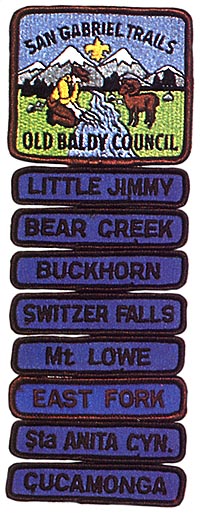| Common links by type of Award | ||||||
|---|---|---|---|---|---|---|
| HOME | Alphabetical | By Council | By Category | By Area | Misc. Links | Gen Requirements |
The SAN GABREIL TRAELS AWARD has been developed to encourage Scout units to
experience backpacking and exploring throughout the San Gabriel Mountain area
and to encourage wise use and proper maintenance of the trails and campsites
within the Angeles National Forest.
This award consists of a main patch and a series of segments which allow the
unit many options as to the trails and trail camps which may be explored.
Each segment requires an overnight backpack outing of at least five (5) scheduled
hours.
John Robinson's "TRAILS OF THE ANGELES" is referenced for appropriate hikes in
each segment area. Current USGS topographic maps should be consulted for trail
details.
SAN GABRIEL TRAILS AWARD AND SEGMENTS

SAN GABRIEL TRAILS AWARD AND SEGMENTS
Requirements:
1. Comply with the GENERAL REQUIREMENTS.
2. Obtain a Local Tour permit from your council.
3. Obtain required Fire Permit and Wilderness Permit.
Check in and out with local USFS or State Park Ranger when possible.
Comply with all USFS and State Park regulations.
4. Complete a backpack application with a roster of participants,
menus, itinerary, and trail profile. Submit the completed form to your
council H.A.T. for approval at least two weeks prior to the outing.
5. At least one of the required two adult leaders participating
on the outing must have completed the basic backpack awareness course
and hold a current Red Cross First Aid Certificate.
6. Each participant shall carry a backpack containing all his personal gear and
a share of the unit equipment and food for a minimum of five (5) scheduled
backpack hours and sleep at least one (1) night in a backcountry trail camp
in one of the listed segment areas. (I backpack hour = 2 miles or 1000 feet
in elevation gain).
7. Each participant must work on a good turn project within the
National Forest for each trail segment earned. Projects involving trail repair and
maintenance require the supervision of a Trail Boss or Forest Ranger.
8. After completing a weekend outing in one of the listed areas, the unit
leader shall file an Award Application and a hike report listing all participants
who earned this award and/or segment. (A three-day, two-night backpack of 10 or more
backpack hours through two adjacent areas may earn both segments).
SAN GABRIEL TRAILS AWARD SEGMENTS
BEAR CREEK
The trail along Bear Creek penetrates the rugged San Gabriel Wilderness. Recommended
trail head starts at Highway 39 below Coldbrook Campground and terminates at the west
fork of the San Gabriel River. The lower trail has many stream crossings and is heavily
covered by poison oak. Trail camps are Bear Creek and Lower Bear Creek.
A side trip for a peak climb is at Smith Mountain. Wilderness permits may be
obtained at Glendora Ranger Station. Reference Robinson's hikes 73 & 74.
BUCKHORN
Buckhom and Cooper Canyon were once campgrounds of the Shoshone Indians and
later served as hunting camps for early settlers. The suggested trek is from
Cloudburst Summit through Cooper Canyon to Mt. Williams. Use of the trail camp
at Cooper Canyon is convenient for exploring the San Gabriel Mountain backcountry.
Review Robinson's hike 60 through 66.
CUCAMONGA
This trek takes you into the western side of the rugged Cucamonga Wilderness.
Access is from the trail head at Ice House Canyon above Mt. Baldy Village or
from Baldy Notch. A wilderness permit may be obtained at Mt. Baldy Ranger Station.
The trail camp at Kelly's offers a base for side hikes to any of the high peaks,
offering impressive views of the area. Consult Robinson's hikes 96 through 99.
EAST FORK
Follow the valley of the cast fork of the San Gabriel River from Vincent Gap
to East Fork Ranger Station for a trip that offers adventure and isolation.
Once a hunting ground for local Indians, the lower canyon has become a haven for
weekend gold prospectors. Good trails take you to Mine Gulch Camp in the shadow
of Mt. Baden-Powell, but the middle section to Bridge-to-Nowhere requires cross-country
skills. Start at either end of the canyon. Wilderness permit is obtained at Big
Pines or East Fork Ranger Stations. See Robinson's hikes 84 to 88.
LITTLE JIMMY
Sheltered on the north slope of Mt. Islip, Little Jimmy is accessible from Islip
Saddle, Crystal Lake or Vincent Gap via the Pacific Coast Trail (PCT). Several
peaks nearby provide challenging side hikes with panoramas of the San Gabriels.
Good water is at Little Jimmy Springs. Refer to Robinson's hikes 76 to 81.
MT. LOWE
Featuring the front range of the San Gabriels and scenic Eaton Canyon areas, Mt.
Lowe also offers a trip into the historic past of the front range. Many of the
access trails leading up from Altadena require steep climbs on exposed slopes.
Trail camps at Mt. Lowe and Idlehour offer year-round water. A trek through Henninger
Flats Forestry Station is worthwhile. Review Robinson's hikes 19 to 33.
SANTA ANITA CANYON
A major portion of the Gabrielino Trail traverses this canyon. The Gabrielino Indians
once migrated into these mountains gathering food. Sturtevant Falls in the lower
canyon is worth the visit. Access to the area is from Chantry Flats or Red Box, with
trail camps at Hogees, Spruce Grove or Devore. See Robinson's hikes 39 to 47 and 49 to 52.
SWITZER FALLS
The Commodore Switzer Trail Camp and Switzer Falls were once two of the most popular areas
during the "great hiking era" of the San Gabriels. Trails that access the area follow
Arroyo Seco and Bear Canyons. Trail camps are at Switzer, Bear Canyon and Oakwilde.
Water generally is available. Consult Robinson's hikes 15 to 18 and 33.